
"S-TTL" Promises Appropriate Exposure Underwater
The S-TTL enables TTL auto shooting by an external strobe for digital SLR cameras as well as for compact digital cameras. INON S-TTL Auto supports any manufactures’ model with its highly accurate exposure control.
Film camera era without strobe selection problem
TTL stands for "Through The Lens". A TTL auto strobe controls flash amount to provide correct exposure based on calculation by camera's internal sensor metering reflecting strobe light from a subject through the lens. This system meters actual light amount reflecting from a subject thus able to provide accurate exposure.
When we start with the history of underwater TTL auto strobe for underwater photography, underwater camera "NIKONOS V" released in 1984 was the first to provide automatic TTL flash control for underwater strobe SB-102, SB-103 succeeded by NIKONOS V compatible underwater strobes from other manufactures. The 5 pin electrical sync connector for the NIKONOS V is the most popular and widely adopted to couple an underwater strobe and underwater film camera (underwater camera/underwater housing).
A film SLR camera has flexibility to select an underwater strobe. As far as a housing has NIKONOS type electrical sync connector and properly wired, automatic TTL flash control is usable with any TTL auto strobe like Nikon SB-105, INON Z-220, INON Z-22 simply connected via electrical sync cable.
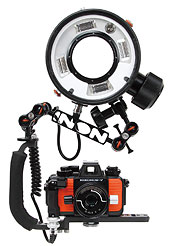
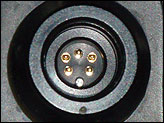
Film camera compatible strobe is not usable for a digital camera!?
Underwater TTL strobe circumstances have been drastically altered with the spread of digital cameras among divers. Some underwater digital SLR camera housings have Nikonos type electrical 5 pin sync connector as like film camera housings. When we plugged same strobe which we used for a film camera housing to a digital SLR housing via NIKONOS 5 pin compatible sync cable presuming that the strobe works, it turned out to observe error indication on the camera or blackout images whilst the strobe fired. Why this happened? This is because how a digital SLR camera controls TTL differs from how film SLR camera does.
The film TTL auto system makes single flash while digital TTL auto system employs pre-flash type making couple of flashes. The film TTL auto strobe system starts firing when the shutter opens and reflecting strobe light from a subject is received at a film. The reflecting light on the film is metered by the camera's internal sensor to determine when to cease firing for correct exposure. This process takes only about 1/1000 second. In contrast, a digital camera cannot calculate adequate exposure based on reflecting light from a subject since an image sensor (CCD/CMOS) reflectivity is comparably low comparing to a film. So the digital camera gives a faint flash (pre-flash) just before the shutter opens metering reflecting light from a subject by the camera's internal sensor to calculate necessary amount of light for correct exposure and bursts main flash at the same time the shutter opens. Canon E-TTL and Nikon i-TTL employs this system.
When we connect conventional film camera compatible TTL strobe to pre-flash type digital SLR via sync cable, the strobe makes full dump by pre-flash signal then the shutter opens before the strobe has been fully charged resulting in quite under exposed image only with ambient light. Even two time flash compatible strobe like INON Z-220 strobe, does not fully support a digital TTL and force to use Manual flash mode.
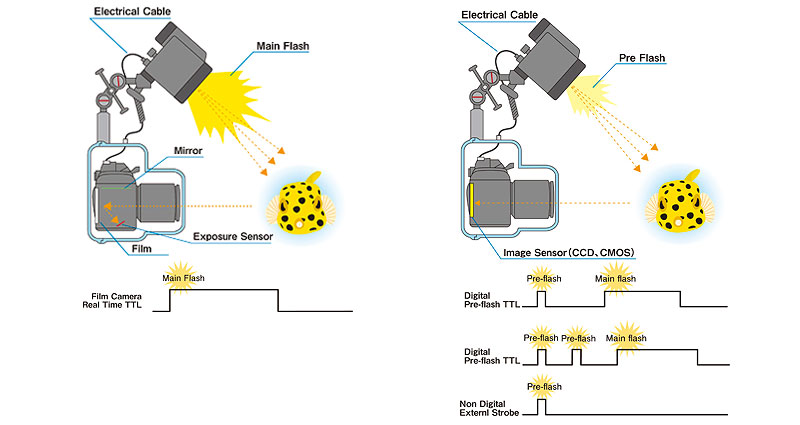
Film SLR:
A strobe starts firing at the same time the shutter opens and quenches firing when correct exposure has been obtained.
A film compatible TTL strobe connected to a pre-flash type digital SLR via electrical cable does not support TTL auto exposure resulting in synchronization only with first pre-flash or totally uncontrollable.
The birth of digital fully compatible S-TTL
Whilst digital cameras quickly took over film cameras for land photography, spread among underwater photographers took longer. Main reason was incompatibility of underwater strobes with digital TTL Auto making hard to benefit fully automatic strobe shooting.
INON is among the first to support digital TTL auto system with S-TTL Auto mode equipped D-2000 strobe and Z-240 strobe.
The proper name of the S-TTL is Optical Synch TTL. The S-TTL enables the strobe to perform in TTL auto exposure as same as genuine TTL strobe from camera manufacture, based on camera's built-in flash light to use as a signal to transmit it to the strobe. The S-TTL uses the built-in flash not as a light source but as like a controller to trigger the S-TTL strobe.
The built-in flash of a digital camera makes weak flash (pre-flash) before main-flash to calculate exposure. This pre-flash is transmitted through fiber optics to an S-TTL strobe to control the strobe to make pre-flash at a subject. The reflecting light from the subject goes through the camera's master lens to an image sensor then a processor determines main flash light amount for correct exposure. Finally the built-in flash makes main-flash which is transmitted to the S-TTL strobe to cause main-flash of the S-TTL strobe.
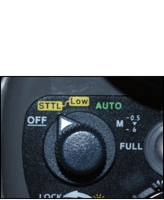
INON Z-240/D-2000/S-2000 strobe supports S-TTL auto exposure simply by setting their main dial to S-TTL position.
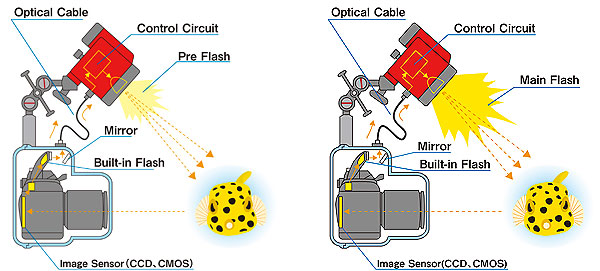
Highly versatile S-TTL
This S-TTL auto system is compatible with any make, model regardless of a compact digital camera or a digital SLR camera as far as the camera has pre-flash type TTL built-in flash. Since the S-TTL works based on optical signal, theoretically there is no limitation on number of strobe to use as long as they are connected via optical fibers.
INON S-TTL strobes also support explosively sold transparent housings among divers with simple and reliable external strobe shooting only by pressing the shutter release button. INON has released a number of "Mount Base" to use attachment lens and "Optical D Cable /Cap (Bush) Set" products to attach an optical cable on compact digital cameras continuously released from camera manufactures; Canon, Olympus, Sony, Nikon, Fujifilm, Panasonic, etc. INON now supports more than 150 different camera models and will successively provide compatible products for latest models.
INON system further includes so called Clear Photo Film to stick on built-in flash surface to change visible light to invisible infrared ray to prevent built-in flash light from leaking not to cause backscatter or exposing suspended particles in an image.
Since S-TTL strobes require digital camera's built-in flash light as a control signal, a digital camera without built-in flash like Canon EOS 5D or Nikon D4 cannot use S-TTL Auto.
Even a digital SLR camera with built-in flash, an S-TTL strobe does not properly work if a housing does not allow the camera to pop-up its built-in flash or does not have structure to properly transmit built-in flash light to an optical fiber. So it is important to check if the S-TTL strobe is usable when you select a camera and an underwater housing.
INON S-TTL strobes work with any pre-flash type digital camera system as far as they make flash underwater, so you can continue to use same S-TTL strobe even you change your camera or housing. An optical fiber is flood-free enabling S-TTL strobe to be shared among two cameras underwater. INON S-TTL would be ideal control system for underwater strobe with its broad versatility and reliable exposure even for multiple strobe system.

4 x Z-240 strobes connected to INON X-2 housing via optical cables.

Wide range of Mount Base products and Optical D Cable Type L/Cap Set products support each different digital cameras.
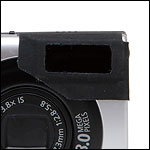
Clear Photo System converts built-in flash light to infrared ray
